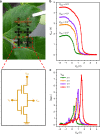Intrinsically ionic conductive cellulose nanopapers applied as all solid dielectrics for low voltage organic transistors
- PMID: 30013115
- PMCID: PMC6048164
- DOI: 10.1038/s41467-018-05155-y
Intrinsically ionic conductive cellulose nanopapers applied as all solid dielectrics for low voltage organic transistors
Abstract
Biodegradability, low-voltage operation, and flexibility are important trends for the future organic electronics. High-capacitance dielectrics are essential for low-voltage organic field-effect transistors. Here we report the application of environmental-friendly cellulose nanopapers as high-capacitance dielectrics with intrinsic ionic conductivity. Different with the previously reported liquid/electrolyte-gated dielectrics, cellulose nanopapers can be applied as all-solid dielectrics without any liquid or gel. Organic field-effect transistors fabricated with cellulose nanopaper dielectrics exhibit good transistor performances under operation voltage below 2 V, and no discernible drain current change is observed when the device is under bending with radius down to 1 mm. Interesting properties of the cellulose nanopapers, such as ionic conductivity, ultra-smooth surface (~0.59 nm), high transparency (above 80%) and flexibility make them excellent candidates as high-capacitance dielectrics for flexible, transparent and low-voltage electronics.
Conflict of interest statement
The authors declare no competing interests.
Figures







References
Publication types
LinkOut - more resources
Full Text Sources
Other Literature Sources

